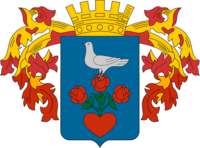Csongrád
| Csongrád | ||
|---|---|---|

Nagyboldogasszony (Holy Virgin) Church
|
||
|
||
| Coordinates: 46°42′40.64″N 20°8′25.01″E / 46.7112889°N 20.1402806°E | ||
| Country |
|
|
| Region | Dél-Alföld | |
| County | Csongrád | |
| Subregion/Micro-region | Csongrádi | |
| Boroughs |
List
|
|
| Government | ||
| • Mayor | Tamás Bedő | |
| • Notary | Dr. László Juhász | |
| Area | ||
| • Total | 183.683 km2 (70.920 sq mi) | |
| • Csongrád | 9.65 km2 (3.73 sq mi) | |
| • Csongrád-Bokros | 0.083 km2 (0.032 sq mi) | |
| Elevation | 83 m (272 ft) | |
| Population (2009) | ||
| • Total | 17,686 | |
| • Density | 107.61/km2 (278.7/sq mi) | |
| Ethnic groups | ||
| • Hungarian | 18653 | |
| • Gypsy | 89 | |
| • German | 19 | |
| • Ukrainian | 8 | |
| • Others | 18 | |
| Time zone | CET (UTC+1) | |
| • Summer (DST) | CEST (UTC+2) | |
| Postal code | 6640 | |
| Area code(s) | 63 | |
| Website | http://www.csongrad.hu/ | |
Csongrád (Romanian: Ciongrad; Serbian Cyrillic: Чонград/Čongrad, archaically also Црноград/Crnograd) is a town in Csongrád County in southern Hungary.
At the time of the Hungarian Conquest (the end of 9th century) the Maros Valley was under Bulgarian control. The fortress was known as Chorniy Grad (Slavic term for 'black castle') and served as a Bulgarian-Slavic guard outpost. Later King Stephen (1000–1038) made the town a state administration center, giving its name to a county. It remained a county seat till the Mongol invasion of Hungary (1240–42). The town and fortress were badly damaged by the Mongols; king Béla IV subsequently transferred the county seat to Szeged in 1247. The move significantly affected Csongrád's recovery. It did not become a town again until 1920.
The Main Square obtained its definitive shape in the first half of the 10th century, its streets are wide with many trees. The Main Street is lined by old plane trees.
The road running along the grammar school in Secessionist style leads to the old town. This part of the settlement, called Öregvár (meaning Old Castle), preserves the structure of a Hungarian fishing-village of the 18th century. The adobes and houses with puddle wall have thatched roofs, many of them are equipped inside with modern furniture. One building can be seen with original furniture (at Gyökér utca 1).
The Tisza has a sand-bank which looks like a seashore.
Another attraction of Csongrád is the backwater generated by the river control works (Holt-Tisza), which houses several water-birds. In the wood strip on the left bank of the Tisza are the uncovered ruins of a Benedictine monastery founded in the 11th century.
Csongrád is a small and very pretty town especially at the summer time when there are lot to see and do. This town is very quiet and peaceful, people are very hospitable and friendly. As the town is small you can get everywhere on foot or if you prefer you can ride a bike, you can cycle through Csongrád on the special bicycle lane.
...
Wikipedia


